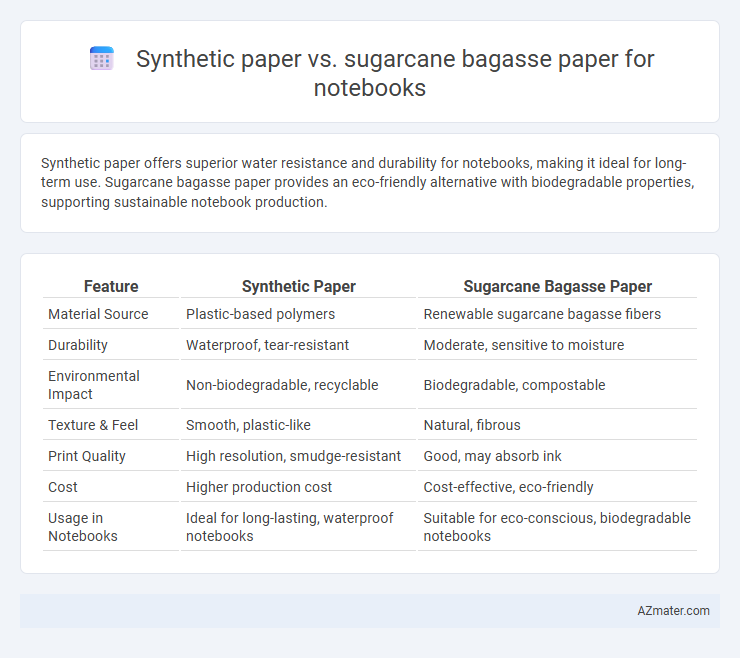Synthetic paper offers superior water resistance and durability for notebooks, making it ideal for long-term use. Sugarcane bagasse paper provides an eco-friendly alternative with biodegradable properties, supporting sustainable notebook production.
Table of Comparison
| Feature | Synthetic Paper | Sugarcane Bagasse Paper |
|---|---|---|
| Material Source | Plastic-based polymers | Renewable sugarcane bagasse fibers |
| Durability | Waterproof, tear-resistant | Moderate, sensitive to moisture |
| Environmental Impact | Non-biodegradable, recyclable | Biodegradable, compostable |
| Texture & Feel | Smooth, plastic-like | Natural, fibrous |
| Print Quality | High resolution, smudge-resistant | Good, may absorb ink |
| Cost | Higher production cost | Cost-effective, eco-friendly |
| Usage in Notebooks | Ideal for long-lasting, waterproof notebooks | Suitable for eco-conscious, biodegradable notebooks |
Introduction to Alternative Notebook Papers
Synthetic paper offers durability, water resistance, and tear-proof qualities, making it ideal for long-lasting notebooks in various environments. Sugarcane bagasse paper provides an eco-friendly alternative made from agricultural waste, promoting sustainability and reducing deforestation. Both materials serve as innovative replacements to traditional wood-pulp paper, contributing to environmentally conscious stationery options.
What is Synthetic Paper?
Synthetic paper is a durable, water-resistant material made from synthetic polymers such as polypropylene or polyethylene, offering tear resistance and longevity compared to traditional papers. Unlike sugarcane bagasse paper, which is an eco-friendly option derived from agricultural waste, synthetic paper is prized for its smooth surface ideal for printing and writing without ink bleeding. Its waterproof and chemical-resistant properties make it well-suited for notebooks used in harsh environments or outdoor settings where longevity is essential.
What is Sugarcane Bagasse Paper?
Sugarcane bagasse paper is an eco-friendly alternative made from the fibrous residue left after extracting juice from sugarcane stalks, offering a sustainable solution compared to synthetic paper, which is typically made from plastic materials. This biodegradable paper supports waste reduction by repurposing agricultural byproducts, making it ideal for notebook production focused on environmental responsibility. Its natural fibers provide a sturdy, recyclable surface, appealing to consumers seeking green stationery options without compromising durability.
Manufacturing Process Comparison
Synthetic paper manufacturing involves extruding polymers such as polypropylene or polyethylene into thin sheets, followed by calendaring and surface treatment to enhance ink adhesion, resulting in waterproof and durable sheets. Sugarcane bagasse paper production starts with processing fibrous residue from sugarcane stalks, which is pulped and then pressed into sheets using traditional papermaking techniques that emphasize sustainability and biodegradability. The synthetic process relies heavily on petrochemical inputs and energy-intensive extrusion, whereas sugarcane bagasse paper leverages agricultural waste and uses a less energy-intensive pulping and pressing method.
Environmental Impact: Synthetic vs Sugarcane Bagasse Paper
Synthetic paper, typically made from petroleum-based polymers, has a higher environmental footprint due to its non-biodegradable nature and reliance on fossil fuels. Sugarcane bagasse paper is produced from agricultural waste, making it a renewable, biodegradable alternative with significantly lower carbon emissions and reduced deforestation impact. Using sugarcane bagasse paper for notebooks supports sustainable waste management and decreases landfill volume compared to synthetic paper.
Durability and Lifespan of Notebook Papers
Synthetic paper offers superior durability and water resistance, making notebooks highly resilient to tearing, smudging, and moisture damage, thus extending the lifespan significantly compared to traditional papers. Sugarcane bagasse paper, derived from agricultural waste, provides decent durability but is more prone to wear and environmental degradation over time. For long-term use and durability, synthetic paper notebooks are preferable, while sugarcane bagasse paper suits eco-friendly, short-to-medium usage needs.
Writing Experience and Paper Texture
Synthetic paper offers a smooth, waterproof surface that enhances pen glide and reduces ink bleed, ideal for vibrant ink and precise writing. Sugarcane bagasse paper provides a natural, slightly textured feel that absorbs ink well, giving a traditional tactile experience favored by eco-conscious users. Writing on synthetic paper feels slick and consistent, while bagasse paper delivers a warmer, organic touch with subtle paper grain influencing pen pressure and feedback.
Cost Analysis and Market Availability
Synthetic paper typically incurs higher production costs due to its plastic-based materials and specialized manufacturing processes, resulting in premium pricing for notebooks made from it. Sugarcane bagasse paper benefits from lower raw material expenses since it utilizes agricultural waste, making it a cost-effective and eco-friendly alternative widely accessible in markets emphasizing sustainable products. Market availability favors sugarcane bagasse notebooks in regions with strong environmental policies and consumer demand for green solutions, whereas synthetic paper notebooks remain niche products with limited distribution primarily targeting durability-focused applications.
Biodegradability and Recycling Options
Synthetic paper offers high durability and water resistance but poses significant challenges in biodegradability and recycling due to its plastic-based composition. Sugarcane bagasse paper is biodegradable and compostable, derived from agricultural waste, making it an eco-friendly alternative with easier recycling processes in traditional paper mills. Choosing sugarcane bagasse paper for notebooks supports sustainable waste management and reduces plastic pollution compared to synthetic paper.
Which Notebook Paper is Better for You?
Synthetic paper offers durability, water resistance, and tear-proof qualities, making it ideal for notebooks used in harsh environments or frequent handling. Sugarcane bagasse paper is eco-friendly, biodegradable, and sustainable, perfect for environmentally conscious users seeking recyclable and compostable notebook options. Choosing between synthetic and sugarcane bagasse paper depends on your priorities: durability and longevity versus environmental impact and biodegradability.

Infographic: Synthetic paper vs Sugarcane bagasse paper for Notebook
 azmater.com
azmater.com